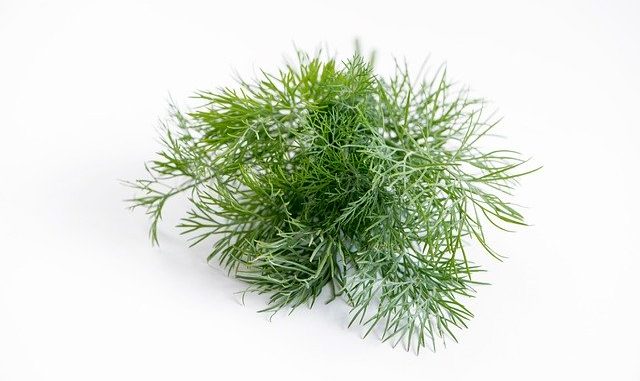
Dill (Anthum graveolens L.) is a herb that has a sweet, aniseed flavour and complements fish extremely well. The seeds are also an important condiment. All parts are used in sauces, salads and principally seafood.
Throughout history, dill was used in the Middle Ages throughout Europe in magic potions to ward off the effects of witchcraft. Over the years it has gained a reputation for treating bloating and flatulence, ameliorating liver issues and overcoming gallbladder issues. Some have found it beneficial in treating urinary tract disorders especially kidney disease and painful urination.
Much of the use of dill comes from both Ayurvedic medicine and various Chinese and Asian traditions.
At an industrial level, dill oil has largely replaced the use of fresh herb. It is produced by steam distillation using fresh herb which is harvested from all parts above the ground. The roots are never used.
Alternative Names
American Dill, Aneth, Aneth Odorant, Anethi Fructus, Anethi Herba, Anethum graveolens, Anethum sowa, Dill Weed, Dillweed, Dilly, Eneldo, European Dill, Faux Anis, Fenouil Bâtard, Fenouil Puant, Huile d’Aneth, Indian Dill, Madhura, Peucedanum graveolens, Satahva, Shatpushpa, Sotapa, Sowa.
Aroma Of Dill
The volatile compounds in both the seed and the herb itself have been analysed by gas chromatography-olfactometry (Blank & Grosch, 1991). The volatiles with highest odour-activity (ratio of concentration to odour threshold) were (+)-(4S)-carvone. The other odorants were (+)‐(3R,4S,8S)‐3,9‐Epoxy‐1‐p‐menthene, methyl 2‐methylbutanoate, (+)‐(4S)‐α‐phellandrene and myristicin.
Nutrition In Dill
Dill is a source of folate which is needed for cell division and DNA synthesis, a source of fibre, of riboflavin for cell functioning and metabolism, manganese and iron.
The vitamin content according to the USDA is:-
- vitamin A (7717 IU, or 154 percent of your daily recommended intake),
- vitamin C (85 mg, or 142 percent of your daily recommended intake),
- folate (about 38 percent of your recommended daily intake)
- riboflavin (17 percent of your recommended intake).
There are small but not insignificant amounts of thiamin, niacin, vitamin B6, and pantothenic acid.
The mineral level is:-
- calcium (208 mg),
- iron (6.6 mg),
- magnesium (55 mg),
- phosphorus (66 mg),
- potassium (738 mg),
- manganese (1.3 mg).
There are small amounts of sodium, zinc, and copper.
Dill Oil
Dill oil is obtained from two main sources, the plant itself and the seed. These two oils differ significantly in composition, especially flavour and quality. The seed oil contains carvone and limonene (Koedam et al., 1979).
Health Benefits
Dill is full of antioxidants. These are compounds that occur naturally and protect cells from damage caused by free radicals.
Role In Diabetes
Research with dill in the area of reducing the risk of type-2 diabetes is still few and far between. There is hardly any research using human subjects but in rats, there may be some impact on changes in serum lipid and corresponding insulin levels where it has been induced by the addition of corticosteroids. A rat study, where type-2 diabetes had been induced by corticosteroids showed that when they were given a leaf extract for 22 days, their serum glucose and insulin levels dropped (Panda, 2008). The plant extract also reversed the drop in levels of thyroid hormones, and enzymes associated with inflammation including superoxide dismutase (SOD).
Soothing Stomach Issues
The seed extracts are claimed to protect the mucosa and influence the secretions from the stomach, although this research was conducted in mice. Dill eases the movement of the bowels and in relieving constipation.
References
Blank, I., & Grosch, W. (1991). Evaluation of potent odorants in dill seed and dill herb (Anethum graveolens L.) by aroma extract dilution analysis. Journal of Food Science, 56(1), pp. 63-67 (Article).
Huopalahti, R. (1984) Effect of Latitude on the Composition and Content of Aroma Compounds in Dill, Anethum graveolens L. Lebensm. Wiss. Technol. 17, pp. 16-19
Huopalahti, R. (1986) Gas Chromatographic and Sensory Analyses in the Evaluation of the Aroma of Dill Herb (Anthum graveolens L.) J. Lebensm. Wiss. Technol. 19, pp. 27-30.
Huopalahti, R.; Linko, R. (1983) Composition and Content of Aroma Compounds in Dill, Anethum graveolens, L., at Three Different Growth Stages. J. Agric. Food Chem. 1983, 31 pp. 331-333
Koedam, A. A.; Scheffer, J. J.; Svendsen, A. B. (1979) Comparison of Isolation Procedures for Essential Oils. I. Dill (Anethum graveolens L.). Chem. Mikrobiol. Technol. Lebensm. 6 pp. 1-7
Panda, S. (2008) The effect of Anethum graveolens L. (dill) on corticosteroid induced diabetes mellitus: involvement of thyroid hormones. Phytotherapy Res. (Article)
Pino, J. A., Rosado, A., Goire, I., & Roncal, E. (1995). Evaluation of flavor characteristic compounds in dill herb essential oil by sensory analysis and gas chromatography. Journal of Agricultural and Food Chemistry, 43(5), pp. 1307-1309.
Schreier, P.; Drawert, F.; Heindze, I. (1981) The Quantitative Composition of Natural and Technologically Changed Aromas of Plants. VIII. Volatile Constituents of Fresh Dill Herb. Lebensm. Wiss. Technol. 14, pp.150-152.
Stanojević, L. P., Radulović, N. S., Djokić, T. M., Stanković, B. M., Ilić, D. P., Cakić, M. D., & Nikolić, V. D. (2015). The yield, composition and hydrodistillation kinetics of the essential oil of dill seeds (Anethi fructus) obtained by different hydrodistillation techniques. Industrial Crops and Products, 65, pp. 429-436.
Nice post. Tried it in a sauce with tarragon.